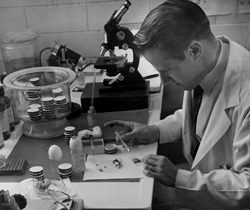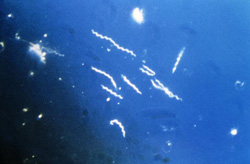Finding the Cause of Lyme Disease
 |
| Willy Burgdorfer, Ph.D., seen here inoculating ticks, discovered the spirochete, or corkscrew-shaped bacterium, that causes Lyme disease. The spirochete was later named for Dr. Burgdorfer: Borrelia burgdorferi. Credit: NIAID/RML |
Borrelia burgdorferi, the bacterium that causes Lyme disease, was first isolated in 1982 by Willy Burgdorfer, Ph.D., a zoologist and microbiologist at NIAID’s Rocky Mountain Laboratories (RML) in Hamilton, MT. The following is a brief history of this groundbreaking discovery.Lyme disease was first recognized in 1975 after researchers investigated why unusually large numbers of children were being diagnosed with juvenile rheumatoid arthritis in Lyme, Connecticut, and two neighboring towns. After considering several causative possibilities, such as exposure to airborne and waterborne microbes, researchers focused their attention on deer ticks. Investigators realized that most of the affected children lived and played near wooded areas. They also knew that the children’s first symptoms typically started during summer – the height of the tick season. Several patients reported having a skin rash just before developing their arthritis, and many recalled being bitten by a tick at the rash site.
About 2,000 miles away at RML, Dr. Burgdorfer was studying Rocky Mountain spotted fever. Dr. Burgdorfer was trying to help Jorge Benach, Ph.D., find the cause of more than 100 cases of spotted fever that occurred in New York from 1971 to 1976. Dr. Benach, of the New York State Health Department, had been a source of American dog ticks for Dr. Burgdorfer to study.
Some 30 years earlier, while a college student in Basel, Switzerland, Dr. Burgdorfer began his studies of tickborne diseases and focused on relapsing fever. This bacterial disease was spread by fast-feeding, soft-bodied ticks that sent infectious corkscrew-shaped spirochetes into their blood-meal hosts. At the time of Dr. Burgdorfer’s collaboration with Dr. Benach, spirochetes in slow-feeding, hard-bodied ticks—such as the deer tick or American dog tick—were rarely found.
In the summer of 1977, Allen C. Steere, M.D., was involved in the investigation of Lyme disease cases for the Yale University School of Medicine. Twice he contacted Dr. Burgdorfer to discuss methods of evaluating, dissecting, and preserving ticks and tissues. During their conversations, Dr. Steere alluded to the deer tick as the likely vector for Lyme disease.
The following year, during a research sabbatical in Switzerland where he continued his tick studies, Dr. Burgdorfer noticed movement between the cells and tissue of six ticks he dissected. The movement came from larvae that were developing into a parasite found in deer.
Here is how all the preceding clues came together, as shared by Dr. Burgdorfer in a 1993 article he wrote for Clinics in Dermatology. Following his sabbatical, Dr. Burgdorfer resumed his Rocky Mountain spotted fever collaboration with Dr. Benach. None of the American dog ticks studied had helped resolve their mystery, so eventually Dr. Burgdorfer suggested they try studying a new tick vector, the deer tick. In October 1981, while testing more than 100 deer ticks that Dr. Benach supplied from Shelter Island, NY, Dr. Burgdorfer noticed in two ticks the same larvae-type movement that he had observed during his 1978 sabbatical.
 |
| Borrelia burgdorferi, seen here magnified 400 times, is transmitted to humans by the bite of an infected deer tick. Credit: CDC |
While investigating the source of the movement, his attention was shifted to something new: long, coiled microorganisms that looked like spirochetes. But deer ticks were the hard species, not known to carry spirochetes. Dr. Burgdorfer recalled a 1949 conference he attended where attendees discussed a little-supported theory on Ixodidae—the family of hard ticks—spreading spirochetes and causing a European skin disorder.Within hours of spotting and confirming the presence of spirochetes in the deer ticks, Dr. Burgdorfer dissected the remaining 124 ticks and found 75 with spirochetes. He cautiously wondered if he had found the cause of both the European skin disorder—erythema migrans—and Lyme disease. After notifying Dr. Benach and receiving serum from recovering Lyme disease patients, Dr. Burgdorfer and his colleagues found antibodies in the patient serum that reacted to spirochetes they had found in the deer ticks.
Further, Dr. Burgdorfer was assisted by RML colleague Alan Barbour in growing the spirochetes in a test tube using tissue from four of the infected deer ticks he had dissected. That exercise was successful, and in late November 1981, the scientists had found the cause of both Lyme disease and the European skin disorder. The study is in the June 18, 1982, edition of Science. For his role, the Lyme-causing spirochete was named for Dr. Burgdorfer: Borrelia burgdorferi.
back to top